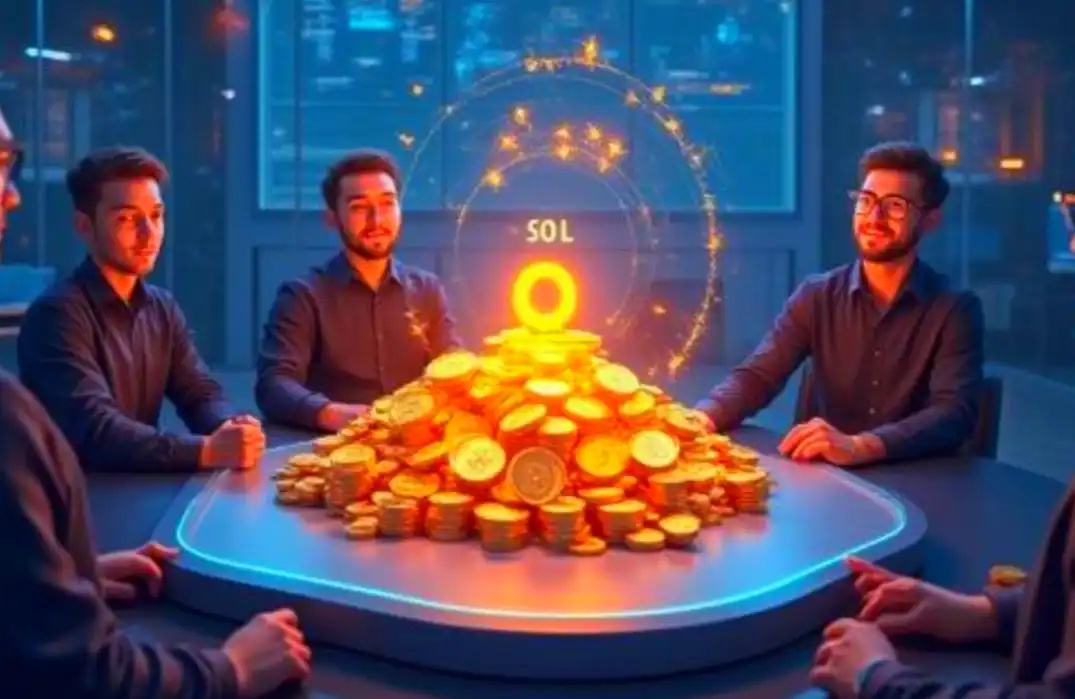Industry Insight: DePIN+AI is Pioneering the Preface of a New Era of DePIN Robotics
Original Title "Industry Insights | DePIN+AI is Shaping the Prelude to the DePIN Robot New Era"
Original Source: DePINone Labs
Abstract
Grayscale's second quarter TOP asset, newly entered three project assets, two of which are related to DePIN. Messari shows that the DePIN track has grown to a 500 billion dollar market value in the first quarter, with the financing scale slightly increasing compared to last year, but the number of projects has significantly decreased, indicating that DePIN is maturing.
Last month, Messari and FrodoBot Lab jointly explored the AI-era robot paradigm revolution built by DePIN+AI, with the main point of view pointing to the development of embodied intelligent AI not only depending on algorithms but also involving hardware upgrades, data accumulation, funding support, and human participation. In the past, the development of the robot industry has been limited by high costs and the dominance of large enterprises, hindering the pace of innovation.
However, the construction of the DePIN robot network means that, with the power of a decentralized network, robot data collection, computing resources, and capital investment can be coordinated globally, accelerating AI training and hardware optimization, lowering the development threshold, allowing more researchers, entrepreneurs, and individual users to participate, while expecting the robot industry to no longer rely on a few tech giants, but to be driven by the global community together, moving towards a truly open and sustainable technological ecosystem.
1. Building the AI Era's Robot Paradigm with DePIN+AI
On February 27, Messari hosted a podcast on "Building Decentralized Physical Artificial Intelligence," featuring FrodoBot Lab's co-founder Michael Cho. In this podcast, Michael Cho emphasized the opportunities and challenges of DePIN+AI in the field of robot technology.
Soon after being fermented by Messari, the concept of the DePIN robot quickly gained popularity, and discussions about the DePIN robot began to proliferate.
Our industry observation this week also focuses on analyzing and discussing observations on this track.
Before diving into our discussion, let's first take a look at the development of artificial intelligence itself in its own track:
· In the computing power field, Nvidia's quarterly revenue has grown fivefold in the past three years;
· In the bandwidth field, the construction of North American data centers has also grown fivefold in the past three years;
· In the energy field, only OKLO alone requires 12.0GW, while TerraPower needs 4.0GW;
· In the data field, large companies invest over $500 million annually in purchasing wholesale data for training AI models.
Against the backdrop of an overall global economic downturn, AI, as the main technological revolution of the next ten or even twenty years, is leading all players in this race (computing power, energy, data) to accelerate at a rate of several times each year.
However, with such rapid development, concerns about AI are also growing. The reason is that if AI computing power (similar to a car's engine), AI large models (similar to controllers and processors), AI energy (similar to oil and fuel), and AI data (similar to raw materials) are controlled by a few centralized giants, then the future technological era may be completely controlled by a few giants, potentially leading to absolute centralization and authoritarianism becoming possible. At that time, we may indeed have opened the largest Pandora's Box.
It is precisely due to these concerns about centralization that a new track and direction are being widely discussed, namely DePIN+AI. And our DePIN ONE is willing to define it as DePAI, that is, DePAI=DePIN+AI.
How will DePAI help decentralize AI better?
We will expand and analyze on the main content of Messari last month and Michael's podcast.
Currently, AI has many pain points. Although they have all kinds of functions, they are all dealing with surface-level information such as text. This type of information is cold and lacks depth of perception and understanding.
The DePIN network can serve as AI's "senses" and "limbs."
The "senses" help AI perceive the real world comprehensively. Some developers are now using ioID and W3bstream to connect real-world devices to the blockchain and use zero-knowledge proofs to verify their actual activities.
The "limbs" can help AI make precise judgments based on its perception and act on those judgments, effectively achieving the system of "training" -> "modeling" -> "automation."
1. DePIN Enables AI to Access More Diverse and Realistic Data
Unlike "online" AI large models trained on vast amounts of internet data, DePIN devices can help AI interact with the real world, obtain more realistic and real-time data, and develop true embodied intelligence for AI+robot and similar devices.
Since DePIN is still in the early stages of development, a large-scale foundation for this does not currently exist worldwide, and there is no consensus on how to collect this data.
We believe that in the future, the data to be collected by DePIN+AI may fall into the following three categories:
· The first category is human operation data, which is the data generated when humans manually control robots. This type of data has high quality and can capture video streams and action labels—showing what humans see and how they respond. This is the most effective way to train AI to mimic human behavior, but it is costly and labor-intensive.
· The second category is synthetic data (simulated data), which is useful for training robots to move in complex terrains, such as training a robot to walk on rough terrain, which is useful for specialized fields. However, for tasks with many variables, such as cooking, a simulated environment may not be as effective. We can imagine training a robot to fry an egg: the type of pan, oil temperature, and subtle changes in room conditions can all affect the outcome, and it is difficult for a virtual environment to cover all scenarios.
· The third category is video-based learning, where AI models learn by observing real-world videos. Although this method has potential, it lacks the direct interactive feedback necessary for true physical intelligence.
With the collection and support of this data, the service capabilities of AI's embodied intelligence will undoubtedly be greatly enhanced.
2. DePIN Enhances AI's Capital Efficiency, Facilitating Decentralization at the Source Rather Than Being Puppeteered by Certain Capitals
Unlike traditional AI models that rely solely on computational power, the implementation of intelligent robotics technology requires the deployment of physical devices in the real world. This presents a significant capital challenge.
Building robots is expensive, and only the wealthiest corporations can afford large-scale experiments. Even the most efficient humanoid robots currently cost tens of thousands of dollars, making widespread adoption utterly impractical.
If we consider the challenges of hardware, data, and evaluation, General Artificial Intelligence (AI) is still far from widespread adoption.
However, the introduction of Decentralized Perception, Inference, and Navigation (DePIN) technology has given everyone a glimmer of hope.
Because the scale and coordination of a decentralized network can effectively distribute the capital burden, even small entrepreneurial teams can develop this technology. To expedite the efficiency of General AI and bring it closer to human-like capabilities, the development of robot technology should be decentralized rather than controlled by a few major companies. Instead of relying on a large company to fund the deployment of thousands of robots, individuals who can contribute could be brought into a shared network.
Furthermore, DePIN has accelerated data collection and evaluation.
No longer do we have to wait for a company to deploy a limited number of robots to collect data; a decentralized network can operate and gather data at a larger scale concurrently.
For example, in a recent AI vs. human robot competition in Abu Dhabi, researchers from institutions like DeepMind and UT Austin tested their AI models against human players. While humans still held the upper hand, researchers were excited about the unique dataset collected from real-world robot interactions. This indirectly proves the need for subnets connecting various components of robot technology. Even though full autonomy remains a long-term goal, DePIN technology has already demonstrated tangible value from data collection and training to real-world deployment and validation.
On the other hand, the DePIN network is helping the landing of AI robots with higher efficiency and lower costs.
A specific example is the collaboration between FrodoBot Lab and the DePIN project, ensuring access to two NVIDIA H100GPU boxes—each containing eight H100 chips of computational power. This provides researchers with the necessary computing power to process and optimize AI models with real-world data collected from robot deployments. Without such computational resources, even the most valuable datasets cannot be fully utilized. Through access to decentralized computing infrastructure via DePIN, the robot technology network can enable global researchers to train and evaluate models without being restricted by capital-intensive GPU ownership. If DePIN can successfully crowdsource data and hardware advancements, the future of robot technology may arrive sooner than expected.
3. DePIN is assisting AI and Embodied AI in achieving more efficient business outcomes
Similar to Sam, an AI agent (a travel KOL robot with a meme coin) showcased a new profit model for the decentralized robotech network.
Sam operates autonomously, livestreaming 24/7 in multiple cities, while its meme coin also appreciates in value.
This model demonstrates how DePIN-driven intelligent robots can sustain themselves financially through decentralized ownership and token incentives. In the future, these AI agents could even use tokens to pay for human operator assistance, lease additional robot assets, or bid on real-world tasks, forming an economic cycle that benefits both AI development and DePIN participants.
Expectations
The development of embodied intelligent AI depends not only on algorithms but also on hardware upgrades, data accumulation, funding support, and human involvement.
In the past, the development of the robotics industry has been limited by high costs and the dominance of large corporations, hindering the pace of innovation. The establishment of the DePIN robot network means that, leveraging the power of a decentralized network, robot data collection, computing resources, and capital investment can collaborate globally, accelerating AI training and hardware optimization, lowering development barriers, and allowing more researchers, entrepreneurs, and individual users to participate.
We also anticipate that the robotics industry will no longer rely on a few tech giants but will be driven by a global community, moving towards a truly open and sustainable technological ecosystem.
II. DePIN Track Data and Insights
1. DePIN Accounts for Only 0.1% of the Trillion-Dollar AI Market
The number of DePIN projects has grown from 100 in 2022 to 1170 in 2024, with the market cap soaring from $50 billion to $500 billion, and the active node rate increasing from 2% to over 50%. However, DePIN accounts for only 0.1% of the trillion-dollar AI market, indicating that this track has the potential for 100-1000x growth.

2. DePIN Funding Amount Rises, but the Number of Fundings Decreases
According to Messari's data, DePIN funding growth remains flat year over year, with the funding amount higher in the first quarter of 2025 but fewer in number.
Q1 2024: 62 Funding Rounds totaling $156 million.
Q1 2025: 36 Funding Rounds totaling $159 million.

Data indicates a scarcity of emerging early-stage projects but a scaling of mature DePIN projects.
Currently, leading projects in each DePIN sector hold a very small global share, presenting an early-stage opportunity in an absolute race.
Wireless Transmission sector market share 0.002% (Helium, leading project), Computational sector market share 0.03% (Filecoin, leading project), Energy sector market share 0.001% (Daylight, leading project), Identity Verification sector market share 0.2% (Worldcoin and Anymal, leading projects).
In the AI race, the agent-based AI market is expected to see significant growth over the next decade, increasing from $520 million in 2024 to $196.6 billion in 2034, with a high 43.8% compound annual growth rate.
3. Grayscale Releases Q2 Quarterly Report, Focuses on RWA, DePIN, and IP Tokenization
Grayscale released its Q2 2025 quarterly report this week, focusing on RWA, DePIN, and IP tokenization, resulting in the addition of three new tokens to the Top 20, namely IP, SYRUP, and GEOD, while removing Akash Network, Arweave, and Jupiter.

The report highlights Grayscale's focus this quarter on tokens that reflect the non-speculative applications of blockchain technology in the real world, categorizing these tokens into the following three types: RWA (Real-World Assets), DePIN (Decentralized Physical Infrastructure), and IP (Intellectual Property Tokenization).
Of the three assets added to the Top 20 asset list for Q2 2025, two are DePIN projects: Maple (SYRUP), Geodnet (GEOD), and Story (IP).
· Geodnet (GEOD): Geodnet is a DePIN project focused on collecting real-time geolocation data. As the world's largest real-time kinematic (RTK) provider, Geodnet offers sub-centimeter-accurate geospatial data, delivering cost-effective solutions to users like farmers.
In the future, Geodnet may provide value for autonomous vehicles and robots. The network has expanded to over 14,000 devices in 130+ countries/regions, and the annualized network fee revenue for the past 30 days has grown to over $3 million (about a 500% increase year-over-year). It is worth noting that compared to other top 20 ranked assets, GEOD has a lower market cap and fewer listings on exchanges, indicating higher perceived risk.
· Story Protocol: Focuses on blockchain-based intellectual property management, more of a decentralized application rather than physical infrastructure, possibly marginalizing into the DePIN category (Story Protocol). Story Protocol is aiming to tokenize the $70 trillion intellectual property (IP) market.
In the AI era, proprietary IP is used for training AI models, leading to copyright infringement claims and large-scale litigations, such as the previous lawsuit dispute between The New York Times and OpenAI. By introducing IP on-chain, Story will enable companies to use their IP for AI model training while allowing individuals to invest, trade, and earn IP royalties. Story has already onboarded songs by Justin Bieber and BTS onto the blockchain and tokenized IP in February.
4. Past Thirty Days DePIN Track Revenue Ranking

The top-performing DePIN project in the past 30 days on Solana

5. Industry Event Tracking
The essential online network service Roam for the global Web3 population has reached 2.8 million nodes, allowing users to achieve seamless cross-border roaming at 30% of traditional carrier costs. Roam plans to launch a similar incentive mechanism in the second half of 2025, where the spatiotemporal data collected by distributed nodes becomes the fuel for training vertical AI models. Phoenix, through partnerships with TandemAI and Origin Quantum, is driving AI integration with decentralized physical infrastructure, helping Phoenix lead in the DePIN-AI field.
IoTeX has launched "Get Goated Season 2," involving token rewards and claiming processes. The claiming window for $IOTX closed on March 27th, and unclaimed tokens will enter the IoTeX treasury pool. Sponsors include Geodnet, Uprock, Drop Wireless, and Network3. The claiming window will reopen on April 7th, with a review period from March 28th to March 31st, using zkPass verification. This move may enhance community participation and attract more users to engage in the IoTeX ecosystem. According to the Helium Q4 report published by Messari, the Helium network's operational data has seen significant growth, with operator data traffic increasing by 555% to 576TB, mobile hotspots growing by 14% to 24,800, and daily mobile witness payments growing by 99%, demonstrating its disruptive potential in the telecommunications industry.
Meanwhile, Helium proposed HIP 138 to consolidate $HNT as the sole token, optimize the economic model, and announced a partnership with Telefónica to enter the Mexican market, covering 2 million Movistar users. In addition, Helium was included in Grayscale's top 20 focused assets and added to Coinbase's COIN50 index, attracting institutional investor attention. In terms of smart city applications, the network has been used for US flood monitoring and forest fire alerts. Helium is expanding through the DePIN (Decentralized Physical Infrastructure Network) model, solidifying its leadership in the Web3 telecom market.
6. Funding Information
The largest DeFi protocol on Filecoin, GLIF, released the $GLF governance token and airdropped 94 million tokens, accounting for 9.4% of the total supply. $GLF will expand to include new features such as loyalty rewards in the future. GLIF is expanding towards a decentralized physical infrastructure network (DePIN), surpassing the Filecoin ecosystem. Currently, GLIF has over $102 million locked in Filecoin and will support more DePIN networks in the future.
The decentralized business network Domin Network announced that it has secured strategic investments from Animoca Brands, KuCoin Labs, Web3Labs.club, IBC Group Official, DWF Ventures, Presto, Outlier Ventures, KnightFury, ThreeDAO, Awakening Ventures, and AB DAO. Domin Network is a decentralized business network that leverages NFTs and DePIN Rollup technology to connect software, hardware, and consumer behavioral data to the blockchain, allowing users to earn crypto rewards by sharing their consumption data.
Welcome to join the official BlockBeats community:
Telegram Subscription Group: https://t.me/theblockbeats
Telegram Discussion Group: https://t.me/BlockBeats_App
Official Twitter Account: https://twitter.com/BlockBeatsAsia


 Forum
Forum Finance
Finance
 Specials
Specials
 On-chain Eco
On-chain Eco
 Entry
Entry
 Podcasts
Podcasts
 Activities
Activities
 OPRR
OPRR








